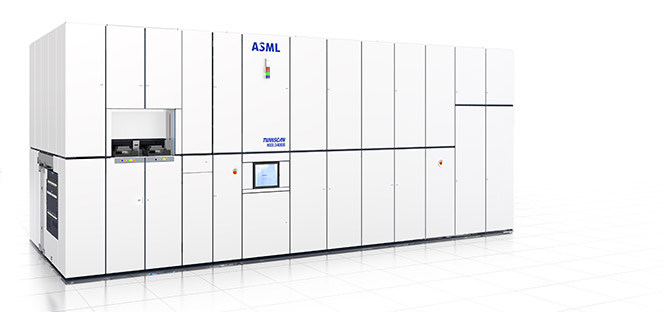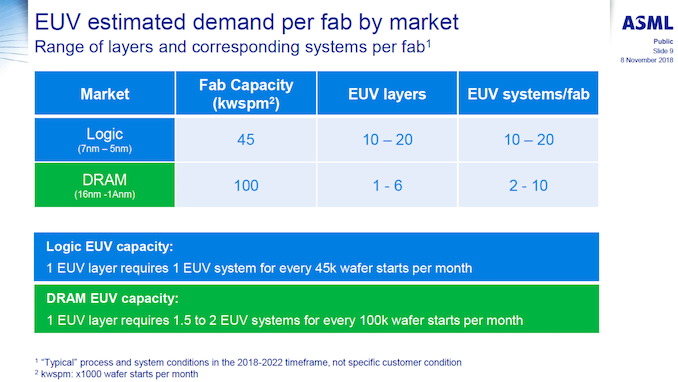ASML to Ship 30 EUV Scanners in 2019: Faster EUV Tools Coming
by Anton Shilov on January 28, 2019 3:00 PM EST- Posted in
- Semiconductors
- Intel
- SK Hynix
- EUV
- EUVL
- ASML
- TSMC
- 7nm
- Samsung Foundry
- 5nm
ASML said last week that it planned to ship 30 extreme ultraviolet scanners in 2019, up significantly from 2018. The plan is not surprising, as demand for EUV lithography tools is rising and semiconductors manufacturers are building new fabs. In addition, ASML indicated plans to introduce a new EUV scanner that will offer a higher production throughput, the NXE: 3400C.
Last year ASML shipped (only) 18 Twinscan NXE: 3400B EUV scanners. This was slightly below its expectations, to supply 20 machines. In total, as of July 2018, there were 31 EUV scanners installed at various fabs across the world, including several machines in various semiconductor research organizations, including imec. If everything goes as planned, ASML will ship more extreme ultraviolet scanners in 2019 than it did in in years before that.
Samsung Foundry has already started to use ASML’s EUV equipment for production of commercial chips using its 7LPP process technology at its Fab S3. As reported, a major increase of EUV lithography use by Samsung will commence after it builds another production line in Hwaseong, which was architected for the EUV tools from the start. The fab is set to cost 6 trillion Korean Won ($4.615 billion), it is expected to be completed later this year, and start high volume manufacturing in 2020.
TSMC is set to start using its Twinscan NXE scanners for commercial wafers in the second half of this year to produce chips using its N7+ manufacturing technology. Initially EUV scanners will be used for non-critical layers, but their use will be expanded at the 5 nm node in 2020 – 2021. TSMC says that virtually all customers that use its N7 fabrication process will also use its N5 technology for their next-gen chips.
Demand for ASML’s Twinscan NXE tools will be further boosted by demand from Intel and SK Hynix. Intel will need EUV tools as it expands its fabs in Oregon, Israel, and Ireland. Besides, the chipmaker will need EUV scanners to equip its Fab 42 in Arizona. These factories will be used to produce chips using Intel’s 7 nm fabrication process. SK Hynix will need EUV tools for its new fab near Icheon, South Korea.
According to ASML, one EUV layer requires one EUV step-and-scan system for every ~45,000 wafer starts per month. As leading makers of semiconductors expand the use of EUV tools going forward, they will need additional scanners, which will naturally increase demand for ASML’s Twinscan NXE products.
Later this year ASML will introduce its new generation Twinscan NXE: 3400C EUV scanner that will be able to process 170 wafers per hour, up from 155 wafers per hour on the NXE: 3400B. The new scanner will use Cymer’s new 340 W light source, which will enable higher performance. ASML’s Twinscan NXE: 3400C will allow chip manufacturers to keep cycle times for their next-gen chips in check.
“We shipped six systems in Q4, which translates to a total of 18 EUV shipments in 2018,” said Peter Wennink, CEO of ASML, during a conference call last week. “With the five orders booked this quarter, our shipment plan of 30 systems for 2019 is covered. In DUV, we shipped 189 new systems in 2018, an increase of 17% over 2017 and we were able to further increase our output in support of the demand from both logic and memory customers. And we continued ramping our latest immersion system, NXT:2000 with a record time to achieve mature customer yields.”
Related Reading
- Intel: EUV-Enabled 7nm Process Tech is on Track
- Intel to Equip Fab 42 for 7 nm
- Samsung Starts Mass Production of Chips Using Its 7nm EUV Process Tech
- TSMC: First 7nm EUV Chips Taped Out, 5nm Risk Production in Q2 2019
- TSMC Starts to Build Fab 18: 5 nm, Volume Production in Early 2020
- ASML Ships Twinscan NXT:2000i Scanner for 7nm and 5nm DUV
- EUV Lithography Makes Good Progress, Still Not Ready for Prime Time
Source: ASML, Seeking Alpha












17 Comments
View All Comments
Sahrin - Monday, January 28, 2019 - link
How much does one of these scanners cost, if they're only selling 30 tools in a year?diehardmacfan - Monday, January 28, 2019 - link
I believe they are about $119 Million, but that might be a previous generation.FullmetalTitan - Wednesday, January 30, 2019 - link
High end DUV (immersion) scanners run in the $120-150M range. EUV scanners are more like $200-300MGreenReaper - Thursday, January 31, 2019 - link
Damn . . . and I thought CanoScan were pricy! ;-pCullinaire - Monday, January 28, 2019 - link
They cost a fortune, and that's not all. Their upkeep also costs a fortune, so there's a recurring revenue stream as well.Ashinjuka - Monday, January 28, 2019 - link
I'm sure it's way more complicated than I could possibly imagine, but when I see these things I always wonder: If you have the knowledge, capability, and capitalization to make something like this, why bother selling it to Intel or GloFo or TSMC?Like how cryptomining ASICs in the big times could be hard to actually get new because the companies that knew how to make them were just making them and then mining with them themselves.
serendip - Monday, January 28, 2019 - link
These machines may be extremely expensive at an Airbus A320 per unit but the cost of outfitting a fab facility is even higher, at several billion dollars each. It's the same reason why Airbus makes planes but doesn't run an airline.saratoga4 - Tuesday, January 29, 2019 - link
>y imagine, but when I see these things I always wonder: If you have the knowledge, capability, and capitalization to make something like this, why bother selling it to Intel or GloFo or TSMC?The scanner alone isn't enough to make chips, so while they have the know how to relay near-x-ray photons, they're not going to be making their own desktop processors.
DanNeely - Tuesday, January 29, 2019 - link
There's a lot more to running a fab than just these machines, and with next gen fabs running $5-10bn each building them is expensive even compared to the machines used to run them.eastcoast_pete - Tuesday, January 29, 2019 - link
ASML won't be making their own chips for four reasons: 1. They are the dominant, but not only player in the scanner market. If they would start competing with their current customers, that revenue stream would be cut down a lot or off entirely fast. 2. They would be subject to the motherload of IP lawsuits and injunctions to stop; as part of their business, they are privy to most manufacturers processes, all covered by NDAs. They'd have to prove that they don'y violate anybody else's IP, public (patented) or just privately shared. As others have pointed out, the lithography process alone has multiple, complex steps besides the scanning. ->3. Same reason why makers of robotic (remote control) surgery equipment (Da Vinci and others) don't open their own hospitals - knowing how to build great equipment doesn't qualify you to run a hospital. and 4. Chip making is insanely capital-intensive and thus financially risky. If you invest billions of $$$ in a fab and are then prevented from getting revenue by lawsuits and injunctions, you go bankrupt quickly. So, even if they wanted to, I don't believe they could get the financing to do this.